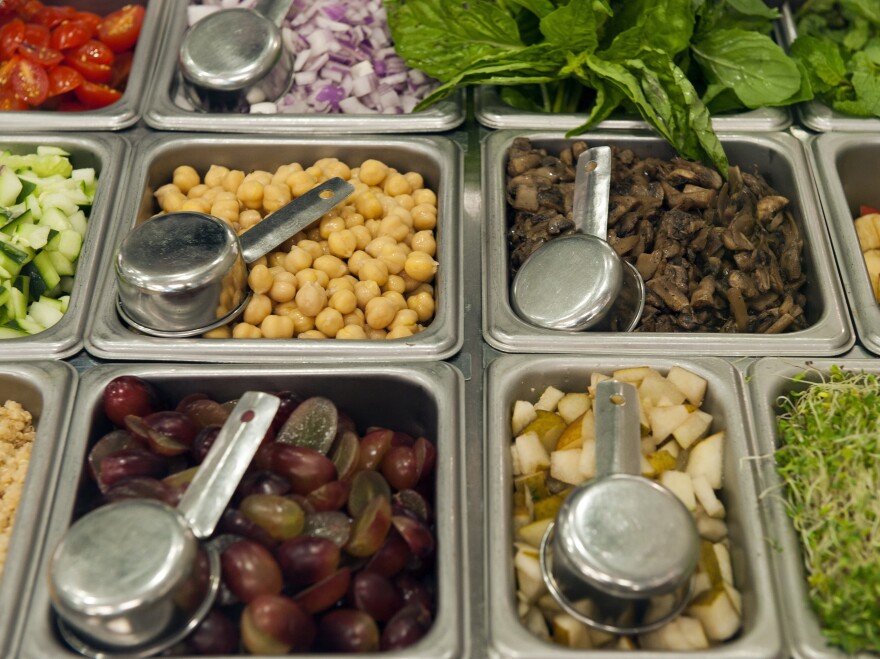About a decade ago, food writer Michael Pollan issued a call to action: Eat food. Not too much. Mostly plants. As 2016 opens, it looks like many American cooks and diners are heeding that call.
Vegetables have moved from the side to the center of the plate. And as another year begins, it appears that plants are the new meat.
Bon Appetit magazine named AL's Place in San Francisco the best new restaurant of 2015. Meats at AL's Place are listed under "sides." The rest of the menu features vegetable-centric dishes sometimes featuring animal protein as an ingredient — pear curry, black lime yellowtail, persimmon, blistered squash. The hanger steak (with smoked salmon butter), however, is a side dish.
This and other restaurants are also using the whole vegetable. What used to go in the compost heap is now fermented, roasted or smoked and used in other dishes. The stem-to-leaf approach follows the example of nose-to-tail eating.
WastED is a project that brings together chefs, farmers, fishermen and food purveyors to "reconceive waste" in the food chain, according to the group's website.
The WastED salad has been available at Sweetgreen restaurants, making use of the restaurants scraps — broccoli leaves, carrot ribbons, roasted kale stems, romaine hearts, roasted cabbage cores, roasted broccoli stalks and roasted bread butts, all mixed with arugula, Parmesan, spicy sunflower seeds and pesto vinaigrette.
Food waste has become a concern to the U.S. government as well as chefs. The U.S. Department of Agriculture and the Environmental Protection Agency have set a goal to reduce food waste by 50 percent by 2030, to "feed people not landfills." The statement says food loss and waste account for about 31 percent (133 billion pounds) of the nation's food supply.
The ascendance of vegetables has added a new word to the food lexicon: spiralizing. Piles of spiralized vegetables — produced with, yes, a spiralizer — are replacing pasta in some home and restaurant kitchens. Cookbooks, blogs and tools are available to help.
Eaters in 2016 also are likely to see more dried beans, peas and lentils on their plates. The United Nations has declared this the to raise consumer awareness of the nutritional and environmental benefits of the edible dry seeds. Chickpeas seems to be the rising star of the pulse world. They're not just for hummus anymore.
The rise of vegetables and focus on food waste are the culmination of more than a decade's worth of government, consumer and food and environmental activists' concerns that have finally trickled into the mainstream. Sustainability issues are becoming particularly visible in the fish we're eating. More overlooked fish and some invasive species are being offered to diners.
So-called "clean labels" are another expression of these concerns. Both consumers and food purveyors are focused on removing GMOs, artificial ingredients, preservatives, antibiotics and growth hormones from food. Even fast-food outlets are using more eggs from cage-free chickens and dumping ingredients that have been genetically modified.
There are generational shifts, too, in the way we eat.
Millenials — now more numerous than baby boomers — have a huge impact. The corporate food world is keenly interested in how and what this large group of consumers eats. And they do buy and eat differently from older generations. They order ingredients online, and learn to cook from YouTube as well as cookbooks and websites. They care about the environment, ethical treatment of animals, and community. They frequently use food delivery services rather than going to the supermarket, and order meal kits that deliver prepared ingredients.
Whatever your age, expect 2016 to be the year not only of the vegetable, but of more awareness of what we spear with our forks.
Copyright 2020 NPR. To see more, visit https://www.npr.org. 9(MDAxNDQ2NDAxMDEyNzU2NzM2ODA3ZGI1ZA001))




